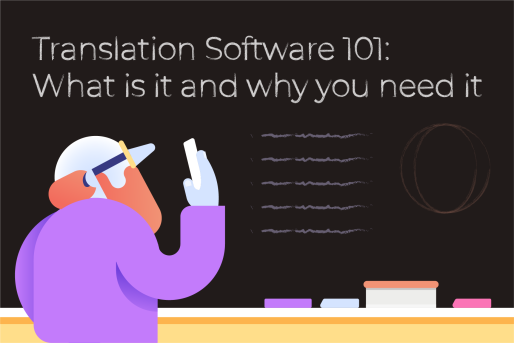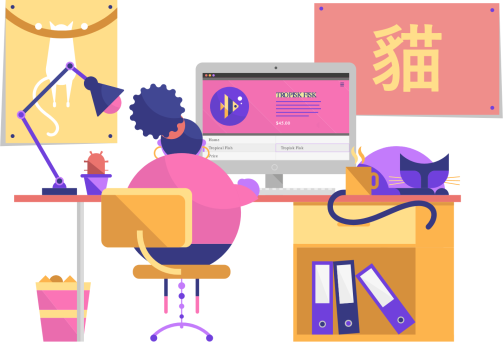Without the right tools, any job will always be more difficult than it needs to. Thankfully, we find ourselves in a time where there is an app or solution for just about every problem.
Need to manage your content online? There’s a tool for that. Need to automate your marketing efforts? There’s a solution for that, too.
Well, the same can absolutely be said for translation. In the past, translators would work on content -- like your brand’s website, software, mobile app, technical documents, etc. -- within spreadsheets, completely separate from the surrounding context.
But, that’s why Computer-Aided Translation (CAT) tools were born. CAT Tools have revolutionized the way that translators and editors work on and manage their projects on a day-to-day basis.
How Do CAT Tools Work?
Designed to simplify and assist in the translation process, CAT Tools enable translators and editors to do their actual work of translating, editing and submitting content.
CAT Tools are made up of several different elements, typically including a string view, linguistic assets, and, in some cases, visual context.
- CAT Tools integrate with your content platform to ingest content
- The Tool then segments your text into strings and presents those strings into bite-sized pieces
- Translation of each string is saved with the source text to build up your translation memory
All of these tools culminate together into a singular platform to empower translators and editors to deliver accurate and high-quality translations while reducing the time spent on each project through a simplified process.
Standard CAT Tool Elements
CAT Tools incorporate multiple features and elements into a single platform for easy access and a simple workspace.
- Source String View - The CAT Tool should display all of the "source strings" ready to be translated all in one clear view. This is how the translator will know what word or segment they are working on.
- Translated String View - Generally coinciding with the source string view, the translated string view is where translators see their work. CAT Tools generally display both source strings and translated strings within close proximity, often right next to each other, for ease of use.
- Translation Memory - Translation memory is your brand's ever-growing database of all previously translated content. Every time a new string is translated, the source and translated text will be entered into your translation memory database for quick access later. This means you only have to translate the same string once, and it will automatically insert anytime that string reappears in other content.
- Keyboard Shortcuts - Keyboard shortcuts are possibly the largest time-saver in a CAT tool. Translators never have to lift their fingers off their keyboard for simple tasks. Smartling even enables translators to customize their own keyboard shortcuts.
While there are several CAT Tool options out there, comprehensive solutions will include these standard elements to assist translators with their work.
The Benefits of Using a CAT Tool
Armed with a CAT Tool, translators can directly improve the outcome of their work in two major ways: faster translations, and higher quality translations.
While these two might seem antithetical, the core benefit of utilizing a CAT Tool is achieved through leveraging the resources available to improve quality while reducing time.
1. Reduce Time, Translate Faster and Smarter
With a Translation Memory always at your disposal, translators can drastically reduce the time they spend on each project.
A well-defined Translation Memory automatically applies previously used translations, cutting down on repetition through automation.
Spell-checkers and quality check functions also enable translators to correct their work on the fly, reducing time spent on internal review and revisions.
2. Higher Quality Translations Every time
With direct access to linguistic assets at every step of the process, along with the previously mentioned quality checks, translators can ensure the highest quality outcome every time.
Linguistic assets, like style guides and glossaries are directly accessible to translators as they work ensure consistency throughout your translations, removing a lot of the guesswork from the process.
Without a CAT Tool, You're Translating Blindly
Without a CAT Tool, translators are essentially working in the past. Translating within spreadsheets is cumbersome and completely lacks context.
CAT Tools enable translators to work smarter and faster, with the resources they need right at their fingertips. Translation memory availability and keyboard shortcuts, for example, are two simple elements that can dramatically improve quality, while reducing the time spent on each translation.
Curious to see if Smartling’s CAT tool is right for you? Chat with an expert to learn more!
About Matt
Matt Grech is the Content Marketing Manager at Smartling, responsible for growing Smartling awareness and brand content. As a digital content writer, Matt applies his journalistic lens to content, helping users deepen their understanding of the brand, services and technology provided by Smartling. Matt has previously contributed to an industry leading Unified Communications resource, as well as local newspapers where he developed his unique ability to investigate, interview, and transform complex problems into simple solutions.

.jpg)





